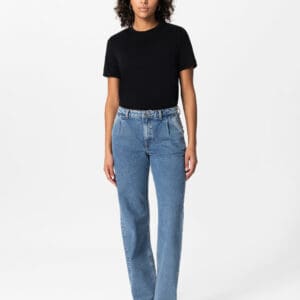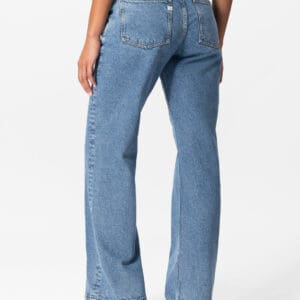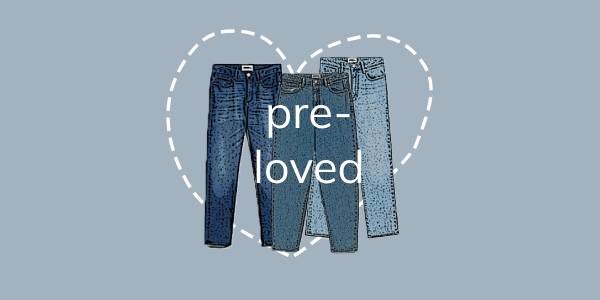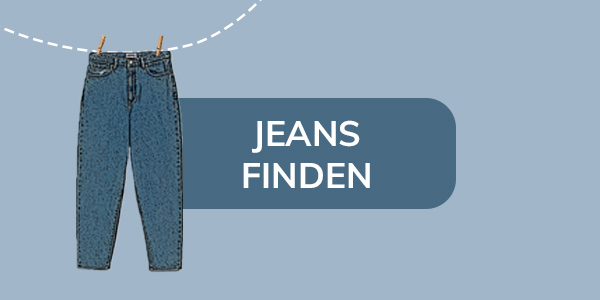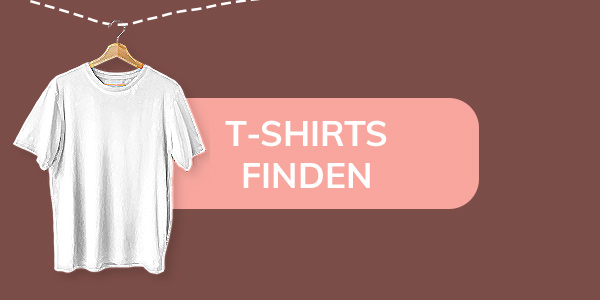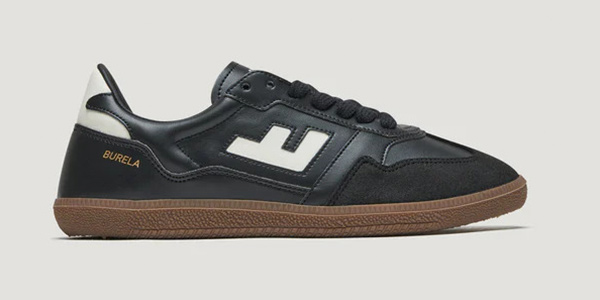

Max R. Gilgenmann im Interview über Jeans und “why polyester should stay the f**** out of our jeans!”
Als Experte, Berater, Moderator und Facilitator formuliert Max Gilgenmann mit dem future fashion forward e.V. (fff) einen eindringlicher Appell für Transparenz und Verantwortlichkeit in globalen Modesupply Chains.
Letztes Jahr bei der 20-20-30 Fashion Konferenz war das Leitthema Denim. Wir haben Max gebeten, für uns Materialien zu bewerten. Auch die wichtigeste Frage wird beantwortet: Wo und wie soll ich mir eine neue Jenas kaufen?

What do you pay attention to when buying jeans?
I pay attention to the material first.
If I like the material, then I consider the
- color and style
- preferably non-stone washed or sustainably finished.
- Next, I focus on the fit and comfort.
I guess nice details also matter because, obviously, jeans are just jeans until you look into the details.
In your opinion, which fibers are best suited for sustainable and circular jeans, and why?
That’s a tough one.
I think cotton is still a very suitable fiber. We need to consider socially well-organized, fair-traded organic cotton or what is nowadays called regenerative cotton, depending on how it’s grown in the end.
It’s also very interesting to look into mixes with cellulosic-based fibers, especially since they offer a lot of recycling opportunities.
Recycled cotton can be interesting since denim, depending on the type, may also be a bit tougher.
Definitely, hemp should be more of an option. I’m afraid it is not always cost-effective, but material-wise it should be. Finally, I’m pretty sure the whole aspect of new-generation fibers always needs to be looked at. I don’t know if we necessarily need them right now for denim because you could drive a very good transformational production style if you focused on regeneratively grown organic fair-traded cotton and hemp. Hemp should also be traded fairly, obviously, and not just considered super sustainable by itself. In terms of circularity, the whole topic of recycling fibers is interesting.
As I said, the idea of using viscose may be very interesting, but I am a bit critical in terms of the quality offerings. So, I’m pretty sure a cotton or ideally a cotton-hemp denim will be much longer lasting than viscose. Nevertheless, bringing viscose into future material mixes could still be an interesting option.
Meanwhile, many fashion labels state that they offer jeans made of 100% recycled cotton. As far as our research shows, due to mechanical recycling, the fibers of cotton are shortened, and recycled cotton must always be supplemented with virgin cotton.
Do you agree, or is it possible to have jeans made of 100% recycled cotton without limiting the wearing comfort and quality?
Well, the short answer is yes, I believe that’s possible! Indeed, I know it’s possible since it has been done by different brands. I think one of the interesting examples is MUD Jeans.
In general, the brand MUD Jeans has a very strong management direction towards the circular economy. They offer renting jeans, not just buying them, and they have 100% recycled cotton jeans.
There are even t-shirts made from 100% recycled cotton. T-shirts have to be way softer and more delicate than jeans in terms of wearing comfort.
I’m sure there are a lot of challenges to scale recycled cotton into such a big industry and make it really workable for everybody and all the different machines. In theory, at least, it has already been proven that this is possible without compromising comfort or quality more than needed.
Elastane is a popular fibre used in denim to provide greater comfort when wearing.
Various experts have stated to us that jeans containing 2-6% elastane next to cellulosic fibre as cotton, Tencel or hemp can be mechanically recycled from old jeans. However, according to the Made-by Benchmark, elastane is not recommended as an ecological alternative compared to other fibres.
Do you consider the use of elastane as critical?
Yes, I do consider the use of elastane as critical but not necessarily impossible.
I think one needs to be pragmatic and realistic, especially since the introduction of elastane into denim. That’s part of the growth factor of denim and also contributes to making denim more inclusive for different body types.
Elastane, depending on whom you talk to, is still considered a very positive invention because it allows people with non-normative body types to more easily choose fashionable clothing.
The way forward is to be more conscious. I emphasize again that not every pair of jeans in the world needs to have elastane. There is a nice variety of jeans that are comfortable and maybe even more exciting without elastane.
But who can blame someone who, having once worn super comfy, fitted jeans with elastane, might only want to wear such jeans in the future? 🙈
The other option is to find a way to have elastane that works in recycling and doesn’t hinder the recycling of the cotton or other materials involved. This could be because the elastane is bio-based and can be dissolved, becoming a byproduct of the recycling process and hopefully used in making new elastane.
Or it needs to be usable in the overall recycling process, though I’m not sure if that is technically possible.
In short, I see the use of elastane as critical, but not in the sense of demonizing it.
We need to look at it closely and carefully, see where it makes sense to use, and in what way.
We need to be critical and ensure that there is a lot of research into scaling the availability of alternatives to elastane with the same functionality.
If so, are there already meaningful ecological alternatives to elastane that can ensure the stretchability of jeans?
Yes, there are biodegradable elastane options available—don’t ask me for brand names right now or specific ingredient brands; I’d have to look those up. But it’s already being used in all kinds of products, and it works!
I’m sure it might still have a few performance challenges compared to traditional elastane, which has been used for so many years and with which we have so much experience.
However, I see no reason why this alternative elastane shouldn’t become the main choice in the market at some point. The only question is when that will be.
During our research, we came across articles that promote a blend of cotton, polyester, and elastane as ideal fibre components for high comfort. We also find this sort of fibre components among various fashion labels (Polyester – PET or rPET, Cotton, Elastane) Some fashion labels justify the use of recycled polyester in certain jeans in their collection for “performance reasons.”
From your perspective, does it make sense to use polyester as a fibre component alongside elastane and cotton, also considering its recyclability and therefor circularity?
Well, here I would be a bit more strict and say, no!
Get the fuck out of my jeans, dear polyester.
You don’t belong there, recycled or not.
Obviously, polyester has some strengths, but I think it works against the core existence of denim, which is all about developing a used look. You don’t get a nice used look with polyester; from my point of view, you need natural fibers for that nice patina.
I can understand the theory that denim jeans could last longer with the smart use of polyester in the overall fabric construction. But really, in terms of the cultural and aesthetic beauty of the product, as well as the sustainability performance, one should not consider using polyester in any denim, from my point of view.
Regarding chemical and water management, which finishing processes do you consider environmentally acceptable, and how can consumers recognize this?
Well, I mean in an ideal world we don’t need any extra finishing because that’s the beauty of denim. It kind of finishes itself while people wear it.
So actually, I used to have this idea of creating a denim brand many years ago that where every denim jeans would be worn in by somebody instead of going through like a chemical or mechanical whatever process of kind of stone washing or destructing destroying stuff.
Well that brand never happened but even there was a brand that at some point did do this idea to certain degree. I think they had prison inmates wear in their jeans and then they would offer them. I guess this is not going to be the mainstream thing but in that sense my first answer is you shouldn’t need much of any kind of finishing.
On the mass market obviously again being pragmatic and realistic okay there will be finishings in all kind of ways.
So, well I’ve seen sanding with sandpaper literally by hand in Bangladesh with a lot of people. I would say that could be okay, there it’s more a social question in terms of:
- how exhausting the work is?
- how bad is the working conditions?
- is the air quality, ok?
These kinds of questions should be asked considering social standards.
Besides that, putting manual work to create a used look I would say that’s still kind of okay at least from an environmental point of view.
Then obviously we have all these laser technologies nowadays. That’s very exciting and been widely used and can be used very creatively. I guess that’s also good for the industry. You can really plan your used look and create quite crazy stuff and also combine it with designs. So I think from a creative point of view and also from an environmental point of view that kind of seems to be quite an exciting technology.
Obviously, we need to make sure that then the energy that is used also comes from renewable resources which occurs for all kind of other processes. For example, like the ozone bleaching technologies which also definitely are much preferable compared to let’s say for example stone wash.
I mean just ask the inventor of stone wash if he is still happy with his invention or why he was part of inventing new technologies like laser and ozone wash in the last decades.
What advice would you give to our readers who are currently looking for a new pair of jeans?
Well first of all at the end of the day I still must say:
The most important part is that you are really gonna love your jeans and want to keep it as long as possible, take care of it and repair it or do whatever is needed.
The goal should be to achieve the longest life possible definitely for a piece of jeans. This is the most sustainable thing you can do obviously to a certain degree also wash it the least possible. There’s a lot of different series around that how little one needs to wash the jeans. You have to find that out for yourself but there’s a lot of different guidelines for that. Some people even claim you never need to wash your jeans. I think hygiene wise you have to decide that for yourself.
Then there are several websites and platforms offering marketplaces for fair fashion as well as sustainability ratings for brands. Not that any of these systems would be perfect but they give you a certain orientation. What you can definitely do is also look for brands that have cradle to cradle certified denim jeans that is kind of possibly one of the highest standards and there’s silver and gold levels cradle to cradle certifications. There is also a famous German sustainable fashion brand that has been investing a lot of time to detox their denim. I also did already mention another denim brand before.
Well, the last element maybe to add here I think denim really also needs to look into its social role and I think most exciting is a development and an area that we had on our last 20-20-30 pop-up conference that was fully focused on denim.
We had the lovely Auf Augenhöhe brand there that looks into inclusive adaptive fashion. Denim is obviously for people with different body types one of the main fashion products that they would like to have. It maybe also be one of the most complicated ones. This is a very interesting context to look into adaptive inclusive fashion from a denim perspective.
The industry pioneer Marian von Rappard of Dawn Denim opened up the 20-20-30 pop-up conference with his keynote and I think you can take any very great inspiration from his keynote. They are also looking into this topic now how to create more inclusive denim.
Dawn Denim is definitely a total leader in sustainability in denim. From a social point of view they are leaders in the Fair Wear Foundation which is also still something not everybody can claim.
Jeans von Dawn Denim und MUD im Preisvergleich



 €99.00
€99.00


 €99.00
€99.00



Relax Rose dip black
JeansMit den folgenden Codes kannst du bei Loveco nochmal sparen:€47.00 - €129.95- save5: spare 5 € ab 75 € Einkaufwert
- save10: spare 10 € ab 150 € Einkaufswert
€47.00 - €129.95


 €129.95
€129.95







